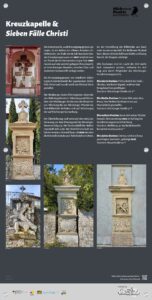Chapel of the Cross & Seven Falls of Christ
The Chapel of the Cross, also known as the Crucifixion Group, is an extension with open arcades with half-columns, which was built at the end of the 17th century over the crucifixion group from 1627. When the church was extended in 1907, the Chapel of the Cross to the west also had to be moved to its current location between the choir and the south aisle.
The crucifixion group made of sandstone also forms the end point of the so-called Seven Falls of Christ and was probably designed by Michael Kern.
The Höchberg Seven Falls begin above the Hofbräu brewery grounds in Würzburg and lead across Würzburger Straße and the centre of Höchberg to the Höchberg parish church. Three wayside shrines are located in Würzburg, four in Höchberg.
According to tradition, the shortened Way of the Cross was created against the backdrop of the persecution of witches at the time. The prince-bishop’s court servants, under the leadership of the kitchen master, Konrad Bauer, had the altar-like wayside shrines and relief panels built from 1626.
The sandstone wayside shrines were probably created by the sculptors Michael Kern, his pupil Balthasar Grohe and Georg Brenck, the younger, were probably involved in making the sandstone wayside shrines.
All of the stations have been restored several times over the course of time, in some cases on behalf of and by members of the Höchberger Verschönerungsverein.
The fourth station: Pilate breaks the staff – Christ, lying on the ground, is beaten by the soldiers
Location: Würzburger Straße 107 A 9
The fifth station: Christ falls under the cross; newly sculpted by Herbert Spielmann from shell limestone.
Location: Würzburger Straße 57 10
The sixth station: Jesus is stripped off his clothes; restored in 1992 on behalf of the Höchberg Beautification Association.
Location: Höchberg, at the bus stop Karwinkel out of town 11
The seventh station: Christ is nailed to the cross; sandstone, made in 1627
Location: Hauptstraße 44 12

